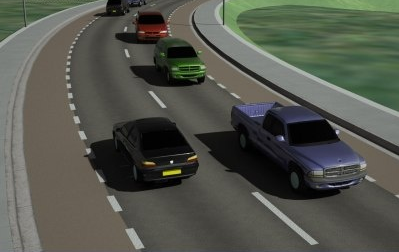The VSPCFG file controls how materials are applied to Autodesk Civil 3D objects in 3ds Max.
The VSPCFG file is used to determine how the contents of the Autodesk Civil 3D model should be interpreted by 3ds Max. This configuration file is used primarily to determine the way in which subassembly classes, link codes, surface names, and render texture names are automatically mapped to materials.
If necessary, differing VSPCFG files may be created which relate to the requirements of each project.
You can open the VSPCFG file by using the Edit button in the Export to Civil View for 3ds Max dialog box.
From the VSPCFG file, it is possible to control:
- the texture which is applied to each individual surface or portion of a corridor surface. Corridor surfaces may be divided either by subassembly class or subassembly link code.
- the way in which each texture is applied to each individual surface or portion of a corridor surface. Through custom tiling parameters and alignment-aware texture mapping functionality, corridor subassemblies can be mapped with scalable textures that automatically follow the alignment of a road.
The VSPCFG File Structure
The file is set up in lines. Each line represents a match between a string and a 3ds Max Material ID value: Mask ; id ; u-tiling ; v-tiling ; type
mask = Full or partial name matching string based on the contents of the type field
id = The 3ds Max material ID which should be applied to the identified surface/subassembly/link
u-tiling = Texture tiling distance to be applied in the "U" direction (lateral)
v-tiling = Texture tiling distance to be applied in the "V" direction (longitudinal)
type = The type of match to be made
- Mask
-
Allows a full or partial name to be specified to identify objects or components in Autodesk Civil 3D such as subassembly classes, subassembly link codes, materials, or surfaces. Supported wildcard characters in this field are:
- * for one or more wildcard matches
- ? for one alphanumeric character
- # for one numeric character
- Material ID
-
Civil View uses a multi-channel (multi/sub-object) material definition which is automatically applied to all imported surface geometry. This material definition is known as the CivilViewSurfaces Material Definition.
The automatic assignment of material IDs to every face/triangle of each imported surface ensures that materials are always correctly assigned upon import into Civil View. No direct interaction with the Materials Editor in 3ds Max is necessary.
- U-Tiling and V-Tiling Values
-
Specifies the texture tiling distance to be applied in the "U" and "V" direction.
"U" means:
- laterally across a link or subassembly for corridor surfaces.
- The X (easting) axis for ordinary surfaces.
"V" means:
- longitudinally along the length of a corridor baseline/alignment for corridor surfaces.
- the Y (northing) axis for ordinary surfaces.
U-Tiling and V-Tiling values can be specified as positive or negative values:
- A positive value represents the distance over which the texture should be repeated in the available object space (for example, 10.0 means repeat the texture every 10.0 meters/feet).
- A negative value represents the number of times that the texture should be repeated in the available object space (for example, -2.0 means repeat the texture twice no matter what distance is available).

- Match Type
-
Determines the type of object or sub-object that the current line in the VSPCFG file will attempt to match against.
The following match types are possible:
- SURFACE - match against the surface name (surfaces only)
- MATERIAL - match against the surface material name (surfaces only)
- LAYER - match against the surface layer name (surfaces only)
- STYLE - match against the surface style name (surfaces only)
- LINK - match against the subassembly link name (corridors only)
- SUBASSEMBLY - match against the (full) subassembly class (or macro) name (corridors only)
Tips About the VSPCFG File
- VSPCFG files are not case sensitive.
- Rules are processed in sequential order (that is, the first match takes priority over any subsequent match).
- Lines starting with ";" are interpreted as comments.
- End of line comments are allowed after ";".
- Whitespace is allowed between ";" separators.
- Any line not matching the above formatting rules will be ignored.